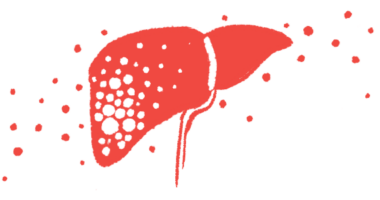Kaftrio Eases Abdominal Symptoms Among CF Patients in Germany, UK

Six months of Kaftrio (elexacaftor-tezacaftor-ivacaftor), which is marketed as Trikafta in the U.S., led to marked reductions in abdominal symptoms among people with cystic fibrosis (CF), a study in Germany and the U.K. found.
“To our knowledge, this is the first study assessing gastrointestinal symptoms, with a validated CF-specific [patient-reported outcome measure], in [people with CF] receiving a CFTR modulator therapy,” the researchers wrote. “We demonstrate that therapy with [Kaftrio] results in a substantial reduction of abdominal symptoms.”
The study, “Elexacaftor-Tezacaftor-Ivacaftor Treatment Reduces Abdominal Symptoms in Cystic Fibrosis-Early results Obtained With the CF-Specific CFAbd-Score,” was published in Frontiers in Pharmacology.
In the European Union and the U.K., Kaftrio is an approved treatment marketed by Vertex Pharmaceuticals for CF patients with at least one F508del mutation in the CFTR gene — the most common CF-causing mutation. It’s been shown to be highly effective at improving lung function and restoring a more healthy body weight for these patients.
While easing lung symptoms is often the primary goal in trials of CF therapies, problems with digestion and gastrointestinal (GI) symptoms are common and can have significant influence on quality of life.
A team of researchers in the U.K. and Germany sought to investigate the impact of Kaftrio on abdominal symptoms among 107 patients with CF and at least one F508del mutation who were seen at four German CF centers (68 people) and four U.K. centers (39 people). The patients ranged in age from 12 to 62. Also included were 45 healthy adults from Germany without chronic GI disease or food allergies.
Among the patients, 60 had been using a different CFTR modulator therapy before starting Kaftrio.
To assess abdominal symptoms in the preceding two weeks, patients completed the CFAbd-Score questionnaire before starting Kaftrio and up to 26 weeks (about six months) after treatment had started. It encompasses 28 items across five domains: pain, gastroesophageal reflux disease (GERD), bowel disorders, appetite disorders, and quality of life.
Before starting Kaftrio, patients had significantly higher total CFAbd scores, as well as subscores for pain, bowel disorders, appetite disorders and quality of life impairments than healthy controls, indicating more abdominal symptoms.
At 24 weeks of treatment, CFAbd scores had declined significantly — by 29% — among the patients, as had scores in all five subcategories, suggesting marked reductions in abdominal symptoms. At that time, only scores for bowel disorders remained significantly higher than those in healthy controls.
Female patients had significantly higher pain and GERD levels at the study’s start than male patients. This difference in GERD was eliminated with treatment, but pain remained higher among females after Kaftrio. No other clinical or demographic features, including prior use of CFTR modulators, were associated with CFAbd scores.
Notable differences were observed between patients in the U.K. compared with those in Germany. Specifically, U.K. patients reported higher total CFAbd scores at the study’s start, and, while German patients saw a significant decline in scores with treatment, those in the U.K. showed a nonsignificant improvement.
Further, while pain, bowel disorders, and quality of life impairment were significantly eased in German patients after Kaftrio, the U.K. patients did not show significant improvements.
These differences might be explained by several factors, the researchers said. First, patients seen at the German centers included people who were at least 12 (mean age 21), whereas those in the U.K. had to be at least 18 (mean age 32.9). This older age and more chronic damage may make change more difficult, the team suggested. Other differences might include rates of enzyme deficiencies in the pancreas (higher in the U.K. group), or dietary differences.
“Given the higher levels of symptom burden observed in the United Kingdom cohort after a longer time of [Kaftrio] administration, it is important to further investigate whether the significant reduction in GI symptoms seen after 24 weeks of [Kaftrio] are sustained or attenuate with time,” the researchers wrote.
Several abdominal symptoms, including flatulence, abdominal pain intensity, smelly stools, fatty stools and bowel movement frequency showed improvements with treatment, analyses showed. These symptoms were still more prevalent among patients than healthy participants, however.
Quality of life related to abdominal symptoms also was better with Kaftrio treatment. While many patients previously said their symptoms influenced their physical activity, this was reported less frequently after starting Kaftrio.
As previously observed, Kaftrio was associated with significant improvements in lung function and body weight.
The findings demonstrate that Kaftrio treatment lowers abdominal symptoms in CF patients, the researchers said, noting that the findings also help to validate CFAbd scores as a way to monitor these symptoms.
“Our CF-specific instrument reveals to be highly sensitive for capturing changes during a potent therapy, making the CFAbd-Score a valuable tool for implementation in interventional and observational studies, as well as for use in clinical routine,” the team concluded.








